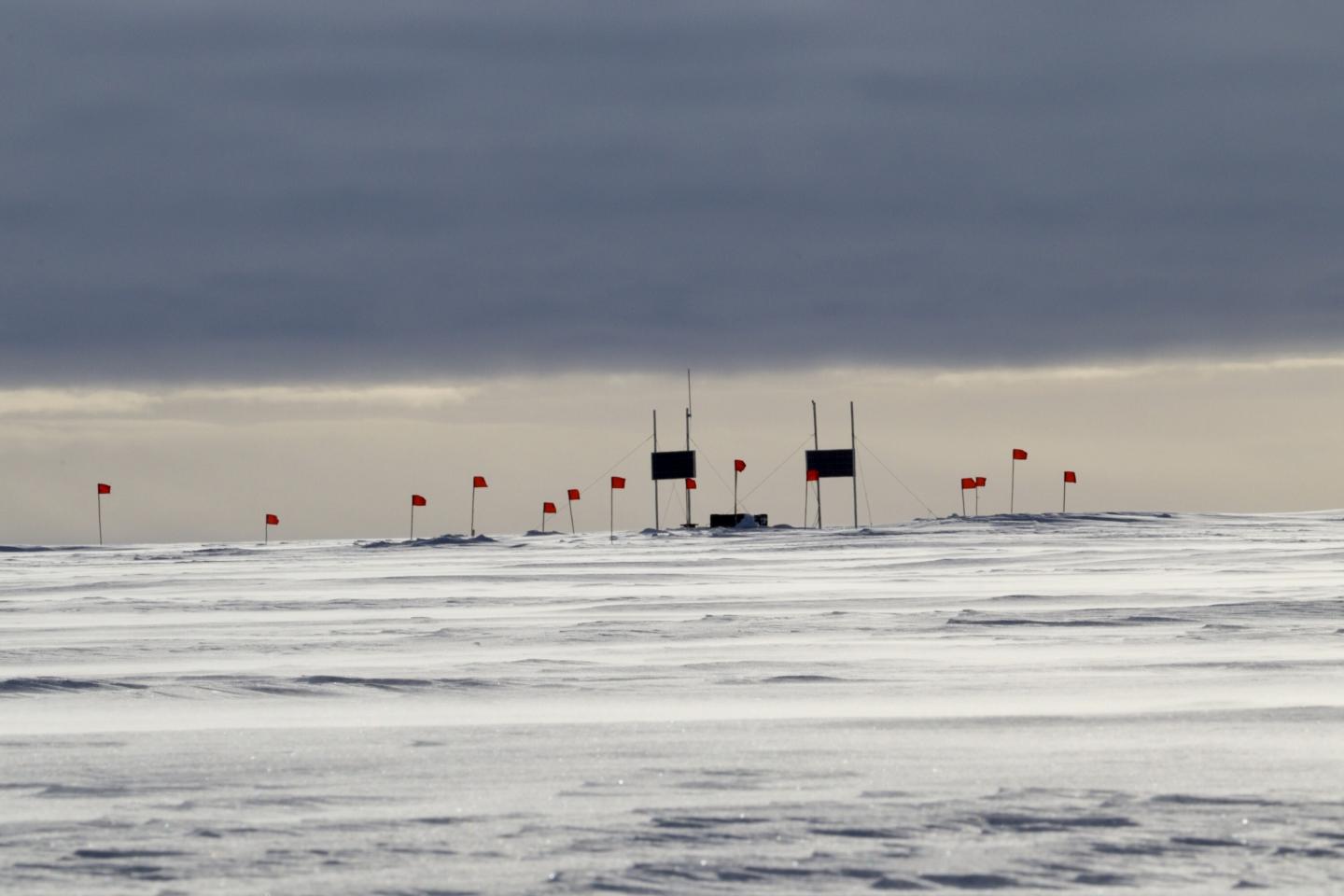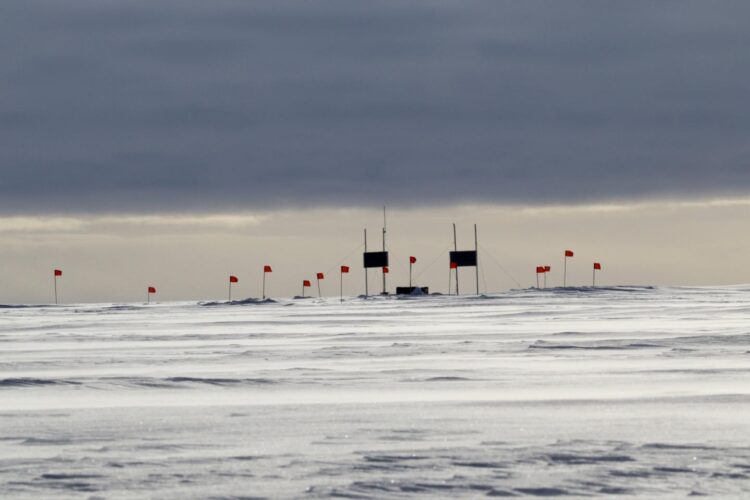Pioneering project listens for neutrinos from outer space

Credit: Credit: RNO-G, Cosmin Deaconu
In Greenland’s ice sheet, a set-up unlike any other in the world will in future be listening for extremely elusive particles from space. The Radio Neutrino Observatory Greenland (RNO-G) is a pioneering project that relies on a new method of detecting very high-energy cosmic neutrinos using radio antennas. The scientists involved in the project have now installed the first antenna stations in the ice at the Summit Station research facility.
“Neutrinos are extremely elusive, ultralight elementary particles,” explains DESY physicist Anna Nelles, one of the initiators of the project. “These particles are created in vast quantities in space, especially during high-energy processes like those that take place in cosmic particle accelerators. But they are very difficult to detect because they hardly ever react with matter. From the Sun alone, some 60 billion neutrinos pass completely unnoticed through a speck on Earth the size of a fingernail – every second.”
The ultralight elementary particles are sometimes called ghost particles because they have no trouble passing straight through walls, the Earth and even entire stars. “This property makes them interesting for astrophysicists because they can be used to look inside exploding stars or merging neutron stars, for example, from which no light can reach us,” explains Nelles, who is also a professor at Friedrich-Alexander Universität Erlangen-Nürnberg. “Also, neutrinos can be used to track down natural cosmic particle accelerators.”
On extremely rare occasions, however, a neutrino does in fact interact with matter when it happens to bump into an atom as it passes through – the Greenland ice sheet, for instance. Such rare collisions produce an avalanche of secondary particles, many of which are electrically charged, unlike the neutrino. This cascade of charged secondary particles emits radio waves that can be picked up by the antennas.
“The advantage of using radio waves is that ice is fairly transparent to them,” explains DESY physicist Christoph Welling, who is currently in Greenland as part of the project team. “This means we can detect radio signals over distances of several kilometres.” The greater the range, the larger the volume of ice that can be monitored, and the greater the chances of detecting one of the rare neutrino collisions. “RNO-G will be the first large-scale radio neutrino detector,” says Welling. Previous smaller-scale experiments had already shown that it is possible to use radio waves to detect cosmic particles.
Overall, the scientists plan to install 35 antenna stations, each 1.25 kilometres apart, around Summit Station on the mighty Greenland ice sheet. Nevertheless, it could take months or even years before the observatory records a signal. “Neutrino research calls for patience,” explains Nelles. “Capturing high-energy neutrinos is an incredibly rare event. But when you do catch one, it reveals an enormous amount of information.” The researchers are also already thinking ahead to the next step, because the next radio neutrino observatory is planned literally at the other end of the world, augmenting the IceCube neutrino telescope at the South Pole.
There, an international consortium, which includes DESY, has installed some 5000 sensitive optical detectors to depths of several kilometres inside the Antarctic ice. These photomultipliers are looking out for a faint bluish flash of light, which is also produced by the energetic secondary particles from one of the rare neutrino collisions as they race through the subterranean ice. Using this technique, IceCube has already succeeded in making some spectacular observations of neutrinos arriving from the vicinity of a gigantic black hole or shattered star, for example. The visible light from the subterranean secondary particles cannot be tracked over such long distances in the ice as radio waves. However, the photomultipliers make up for this by responding to cosmic neutrinos with lower energies.
“The higher the energy, the rarer the neutrinos become, which means you need larger detectors,” explains DESY scientist Ilse Plaisier, who also is part of the installation team in Greenland. “The two systems complement each other perfectly: IceCube’s grid of optical detectors registers neutrinos with energies of up to about a quadrillion electron volts, while the array of radio antennas will be sensitive to energies from about ten quadrillion to a hundred quintillion electron volts.” The electron volt is widely used as an energy unit in particle physics. One hundred quintillion electron volts roughly corresponds to the energy of a squash ball travelling at 130 kilometres per hour – but in the case of a neutrino, that energy is concentrated in a single subatomic particle that is a quintillion quintillion times lighter than a squash ball.
The first stage of installing the equipment for this pioneering project is due to continue until mid-August, and carrying this out during the pandemic has been a huge logistical challenge: teams have had to spend several weeks quarantined at various locations before arriving at Summit Station, to avoid introducing the coronavirus. RNO-G will remain on the Greenland ice sheet for at least five years. The individual stations can operate autonomously, powered by solar panels, and will be connected with each other via a wireless network. Based on their operation, radio antennas are planned to be added to the IceCube neutrino detector at the South Pole as part of its Generation 2 expansion (IceCube-Gen2).
“Detecting radio signals from high-energy neutrinos is a very promising way of significantly increasing the energy range we can access, and thus opening this new window to the cosmos even further,” says Christian Stegmann, DESY’s Director of Astroparticle Physics. “We are pursuing this path via initial test structures in Greenland, and will then go on to install radio antennas at the South Pole as part of IceCube-Gen2.”
More than a dozen partners are involved in the pioneering project, including the University of Chicago, Vrije Universiteit Brussel, Penn State University, the University of Wisconsin-Madison and DESY.
DESY is one of the world’s leading particle accelerator centres and investigates the structure and function of matter – from the interaction of tiny elementary particles and the behaviour of novel nanomaterials and vital biomolecules to the great mysteries of the universe. The particle accelerators and detectors that DESY develops and builds at its locations in Hamburg and Zeuthen are unique research tools. They generate the most intense X-ray radiation in the world, accelerate particles to record energies and open up new windows onto the universe. DESY is a member of the Helmholtz Association, Germany’s largest scientific association, and receives its funding from the German Federal Ministry of Education and Research (BMBF) (90 per cent) and the German federal states of Hamburg and Brandenburg (10 per cent).
###
Media Contact
Dr. Thomas Zoufal, DESY PIO
[email protected]
Original Source
https:/





